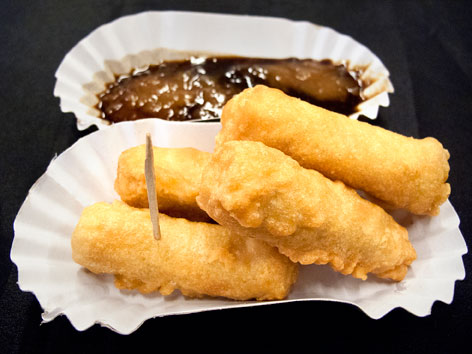Ethiopian Chicken Stew (Doro Wett)
Ethiopia
amantour
guides you to the best local dishes & drinks in
125+ cities. See map now



.jpg) Going somewhere and wish you could take all of a city’s Eat Your World info with you? With EYW’s Kindle and City Guides, you can! Don’t miss out on any local foods or drinks during your next trip.
Going somewhere and wish you could take all of a city’s Eat Your World info with you? With EYW’s Kindle and City Guides, you can! Don’t miss out on any local foods or drinks during your next trip.
EYW wants your food photos!

EYW wants your food stories!
Hey guys I am a traveler who loves to explore different places around the world. I often visit outside of Canada, So whenever I have to travel around the world I always book my flight tickets from the... Read more

What: In Cebu, ngohiong (“ngo-yong”) is the local kin of a spring roll: a deep-fried, battered rice-paper roll containing julienned singkamas (jicama) and/or ubod (technically heart of (coconut) palm, but may also refer to bamboo shoots), ground pork, minced shrimps, garlic, and onions. Seasonings include salt, pepper, and—most important—Chinese five-spice powder (composed of star anise, cloves, cinnamon, Sichuan pepper, and fennel seeds); the starchy, spicy, sweet-and-sour dipping sauce likewise uses Chinese five-spice powder. This is cheap, satisfying, readily available grub, and quintessential Cebuano street food. No surprise, then, that it’s a regular item in eateries or hawker-style stands near schools, offices, construction sites, markets, and shopping centers, as well as in Chinese restaurants.
Good to know: This snack is another ode to Cebu’s strong ties to China’s Fujian province, which is where many Chinese emigrants here hail from. In their language, ngohiong (or ngohiong-hun) simply refers to the five-spice powder that gives fried ngohiong its distinctive flavor. Additionally, while non-Cebuanos may call this dish lumpia (“loom-pya,” from the Chinese popiah), the Tagalog word for spring roll, it’s important to note that while ngohiong is a type of lumpia, not all lumpia are ngohiong. It’s a Cebu thing.
Where: We wanted ngohiong that hadn’t been mass-fried at 8am and steeped in grease by noon, a practice many ready-to-eat ngohiong eateries are guilty of. We found what we wanted at Small Eats Asian Street Food, a hawker-style stand at BTC, or Banilad Town Center (near the Banilad fly-over on Gov. M. Cuenco Ave.), that pops ngohiong into a deep fryer as it is ordered.
When: Daily, 10am-9pm
Order: One serving of ngohiong (Php 16) consists of two finger-length pieces—significantly smaller than what most food courts dish out—alongside the requisite sweet-sour-spicy sauce, which was more of a starchy slurry here (and tasted better than it looked). The ngohiong, lightly salted with an obvious five-spice-powder kick, had a nice crunch coming from both the battered rice-paper wrapper and the ubod wrapped inside. We quickly ordered a second serving, as these are rather addictive and only eventually filling—the kind of thing you can keep shoveling down until you suddenly realize you've had quite a few. For us, it proved a perfect filler in between main meals, though if any Cebuano were asked, they’d say it’s perfect sud-an (or viand; any savory dish) for lots of puso.
Alternatively: Those in the know swear by Domeng’s (Fairlane Subdivision, Guadalupe, map), a home-based ngohiong enterprise that tends to run out by 1pm. But to fulfill a ngohiong craving at any time of day (or night), we like Ngohiong Express (Juan Luna Ave., Mabolo, map), open 24 hours a day, seven days a week.
©2025 Eat Your World, LLC - All Rights Reserved